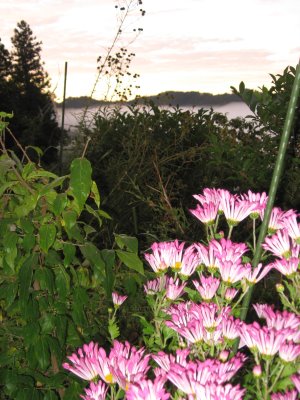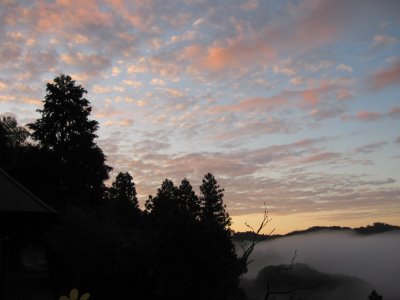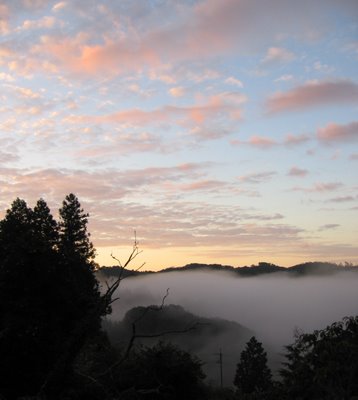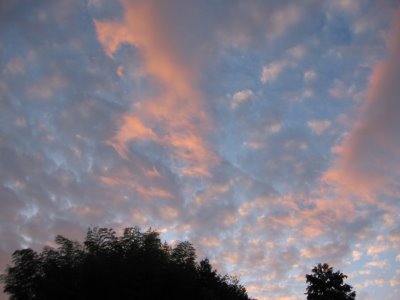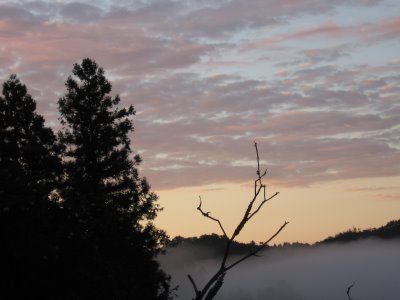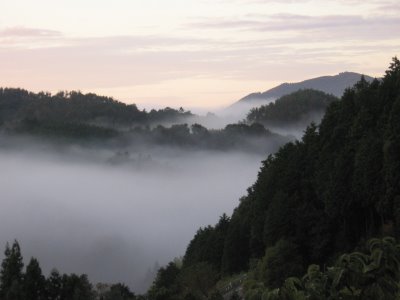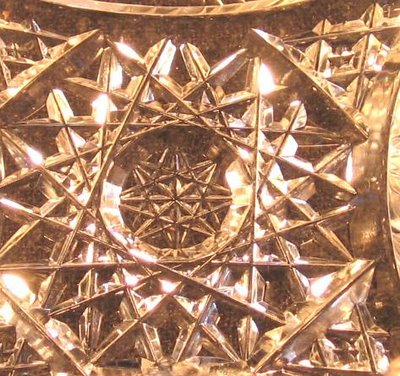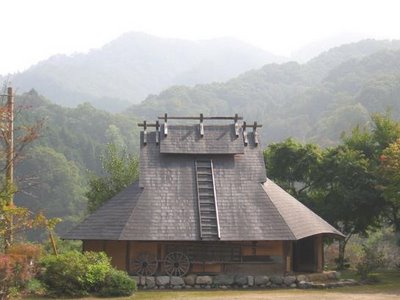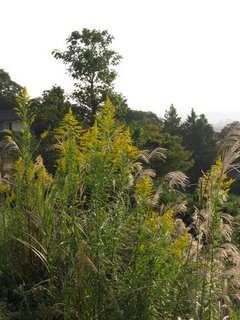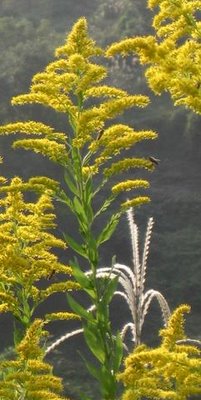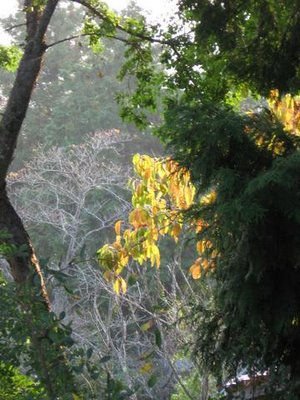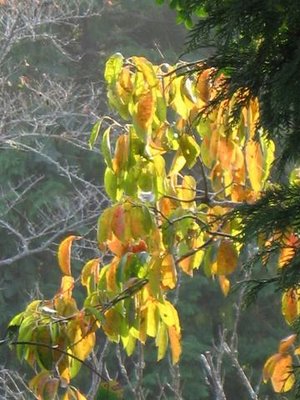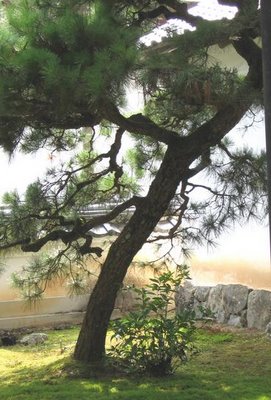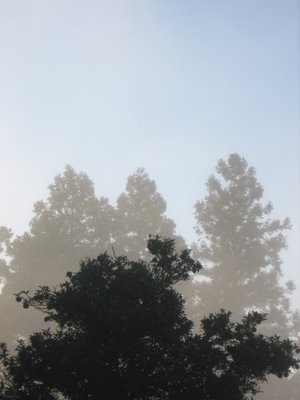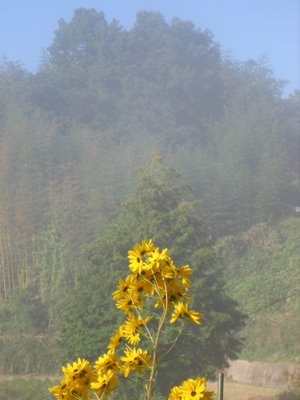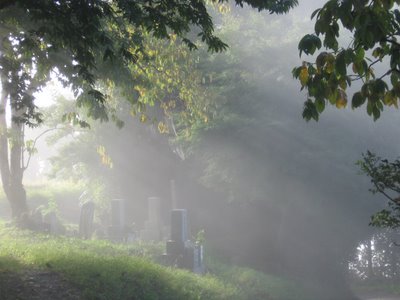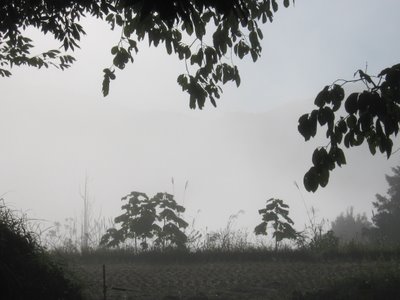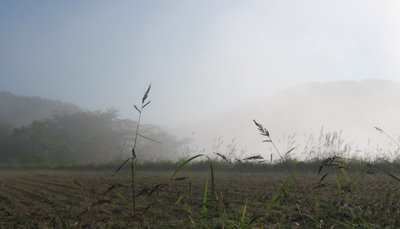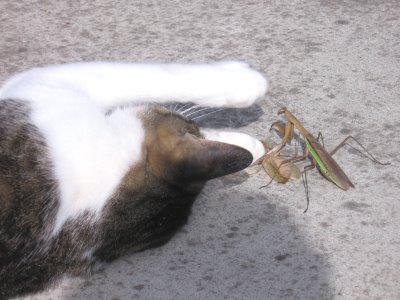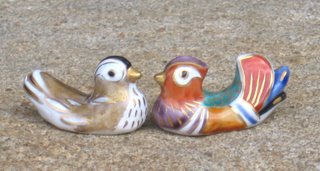天高し 谷間に密そむ 水車小屋

bright autumn sky -
a waterwheel abandoned
in the valley
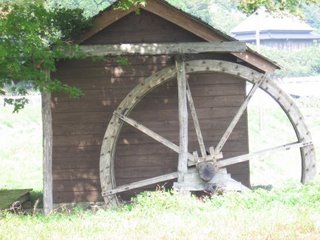
It is a sad sight indeed to find these traces of life,
now put to rest,
in the beautiful valleys of Japan.
The elderly population is no longer capable
to keep them up and running ...
They are the symbol of the problems of rural Japan !
|
Takadono, Metal Manufacturing Hut in Koshihata
My Photo Album
Koshihata Valley, Okayama, October 2006
:::::::::::::::::::::::::::::::::::::::::::::::::::::::::::::::::::::::::::::::::::::::::::::::::::::
humanity kigo for all summer

suisha fumu 水車踏む (すいしゃふむ )
treading the water wheel
..... fumizuisha 踏水車(ふみずいしゃ)
Many water wheels in the Edo period had to be activated by hand, or rather, by foot. Balancing on top, holding on to a pole and stepping from one step to the next.

CLICK for more images of Japanese water wheels .
Wasserrad
Wassermühle (suishagoya)
:::::::::::::::::::::::::::::::::::::::::::::::::::::::::::::::::::::::::::::::::::::::::::::::::::::
dooryoku suisha 動力水車 waterwheel for pounding
soozu 添水 "water provider"
The inner part of the water mill with the hammer to pound and hull the rice was called
 sakonta
sakonta 左官太 / 左近太 / さこんた
sakontaroo 左近太郎 Sakon Taro
sako no taroo 迫の太郎 Sako no Taro
The hammer, mallet was also used to pound earth for pottery.
左近太の嬉々と働く春の水
sakonta no kiki to ugoku haru no mizu
the watermill hammer
moves along happily -
water of spring
Tr. Gabi Greve
Etoo Toyoko 江藤豊子 Eto Toyoko
source : haikudaisuki
:::::::::::::::::::::::::::::::::::::::::::::::::::::::::::::::::::::::::::::::::::::::::::::::::::::

山梨県 - 山中湖村花の都公園
© More in the WIKIPEDIA !
- reference -
:::::::::::::::::::::::::::::::::::::::::::::::::::::::::::::::::::::::::::::::::::::::::::::::::::::

Hokusai - Mount Fuji
Rice brokers
Rice polishing by water mill in early modern Japan.
© More in the WIKIPEDIA !
- quote
" History of Watermills in Hino"
by Sadako Ueno
Watermills in Hino were often described in Kawano Nikki (diary) (from the 2nd year of Keio (1866) to the 45th year of Meiji (1912). I read various diaries including the ones by Keisai Irako and Tamizo Tachikawa, ancient texts, and other documents on watermills in Tokyo Metropolitan Archives. Furthermore, I often put down what I heard and I really got interested in watermills in Hino. History of watermills somewhat suggests history of Hino. At the end of Edo Era, watermills built on irrigation channel of Hino were used for grain cleaning of rice and oats.
Amano Watermill built in 1937, was unique because it was set on a narrow waterway (mawashi-bori) cut from the irrigation channel with difference of height, and water flew through a house. Water volume can be controlled at the intake, enabling to draw only the amount needed to drive the watermill. People usually lived in a private watermill; however rich inhabitants sometimes employ a residential staff. A shared watermill was 2x3 Ken (1ken=about 1.8m), with 4 to 6 rice motors and the mill wheel set outside rarely had millstones. People set rice in turn in the morning, and sometimes stayed at the watermill overnight when graining was not finished because of lack of water. In the Meiji Era, watermills were built in almost every village. Shared watermills were sometimes owned by a half stock; two people used it in turn. They could sell or buy the stock. The family who operated such watermill had often the family name, "Kuruma".
Because the watermill machine was expensive, rich village officers usually manage the watermills and grained for neighborhood charging the rate. The application for a watermill was submit to a local governor within a territory of government of Edo. Building a watermill was difficult because it was required to obtain the approval from Nanushi and villages which had water right, and land owners of surrounding fields. Furthermore, payment to the government was also required. Watermills were built at the east end of Hinojuku, where houses were not found. They grained rice free for neighborhood as a compensation for the resulting noise.
In private watermills, people bought rice from neighborhood and milled to sell to a neighbor town, Hachioji, where demands for rice increased as the growth of population occurred along with the boom of silk industry since the Meiji Era.
An indoor water wheel of 3.4m diameter was driven in the Kaneda watermill (No.17), with 30 rice motors milled rice. Ancient texts show that three watermills existed in Nishi-Hirayama of the Edo Era. Also, large-scaled watermills were lined through No.16 to 22 along the Watermill Street where horse carts and carts came and went carrying rice for mill and milled rice. This area still retains the townscape at the time with old houses and narrow streets.
The watermills for twisting thread existed in Hirayama and Takahata. Hachioji had more watermills than in Hino, most of which were for fabrics with smaller water wheels about 1.0m diameter.
- source : eco-history.ws.hosei.ac.jp
:::::::::::::::::::::::::::::::::::::::::::::::::::::::::::::::::::::::::::::::::::::::::::::::::::::

rice ground with a stone mortar of a water mill named
Daruma An だるま庵
- source : www.sadomon.com/SHOP
:::::::::::::::::::::::::::::::::::::::::::::::::::::::::::::::::::::::::::::::::::::::::::::::::::::

水車小屋伏香炉 incense burner in form of a water mill
Bizen pottery from the kiln Darumagama 備前焼 だるま窯
- source : toukian.seesaa.net
:::::::::::::::::::::::::::::::::::::::::::::::::::::::::::::::::::::::::::::::::::::::::::::::::::::

日本一の水車・大分県 The Biggest Water Wheel of Japan - in Oita
思い出にカッタンコットン水車小屋
omoide ni kattankotton suishagoya
memories
of kattan kotton
of the water mill
- source : naraken10.blog55
:::::::::::::::::::::::::::::::::::::::::::::::::::::::::::::::::::::::::::::::::::::::::::::::::::::
 source : www.rakanneko.jp/buson
舂や穂麦が中の水車
source : www.rakanneko.jp/buson
舂や穂麦が中の水車
usuzuku ya homugi ga naka no mizuguruma
pounding grains -
in the middle of the barley ears
a waterwheel
. Yosa Buson 与謝蕪村 in Edo .
:::::::::::::::::::::::::::::::::::::::::::::::::::::::::::::::::::::::::::::::::::::::::::::::::::::
India
gharat or water flour mills
run on a stream’s kinetic energy to turn the shaft of the grinding mill.The water is diverted from the stream or river along a channel or canal to the water wheel. The force of the water’s movement drives the blades of a wheel or turbine, which in turn rotates an axle that drives the mill.
The Gharat abounds in remote villages in the Indian Himalayan region. Communities that currently use them are concerned that the clean, low-cost technology might vanish altogether as it hasn't managed to capture the attention of policymakers.
source : www.thewaterchannel.tv
quote
The somewhat subdued rolling sound of a continuous friction between heavy stones near the river betrays the presence of a gharat nearby. These gharats have a momentous role in utilization of mechanical power from water streams mainly for grinding purpose.the gharats originated somewhere in the Northeast region around the 7th century. But there is no consensus over the date.
Currently
gharats are in wide use in the whole of the Himalayan range and the Northeast. The populations of the Himalayas, from Afghanistan to Myanmar, still live predominantly in agricultural economies, often at subsistence level. The need for milling is reasonably well served by traditional watermills spread throughout the region. According to some estimates there are over 500,000 watermills in this entire region.
source : www.infinityfoundation.com/mandala
above the grind
of the ancient gharat
the miller's song

Angelee Deodhar
. WKD : India Saijiki .
:::::::::::::::::::::::::::::::::::::::::::::::::::::::::::::::::::::::::::::::::::::::::::::::::::::
[ . BACK to WORLDKIGO . TOP . ]
[ . BACK to DARUMA MUSEUM TOP . ]
:::::::::::::::::::::::::::::::::::::::::::::::::::::::::::::::::::::::::::::::::::::::::::::::::::::
